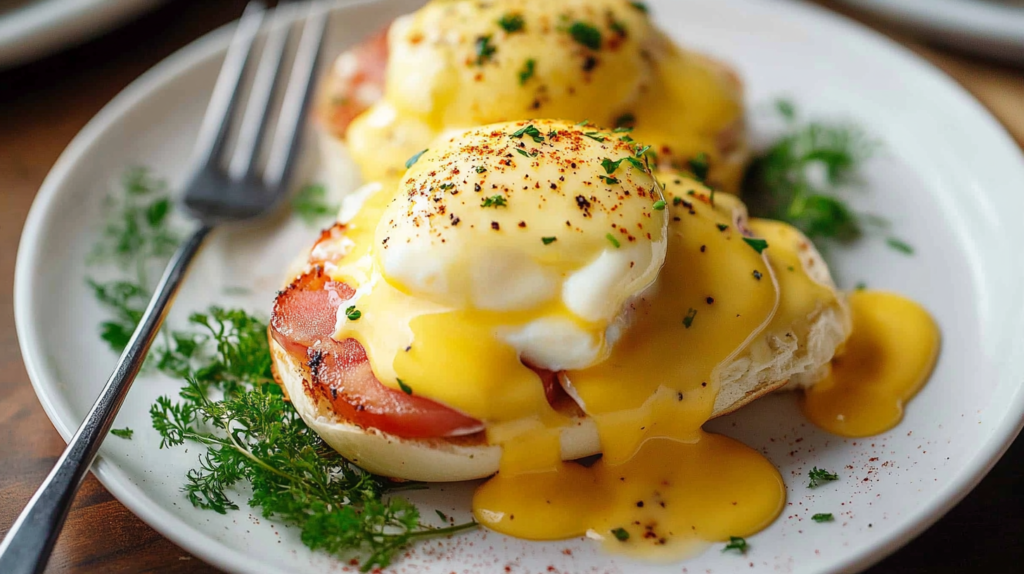Variations and Adaptations of Eggs Benedict

While traditional Eggs Benedict is a classic favorite, there are many creative variations that cater to different tastes and dietary needs. Here are a few popular adaptations that put a unique spin on this beloved brunch dish:
Eggs Florentine
For a vegetarian twist, Eggs Florentine swaps Canadian bacon for a layer of sautéed spinach. The spinach adds a mild, earthy flavor that pairs beautifully with the rich hollandaise sauce. Some recipes even add a slice of tomato for extra freshness and a hint of acidity.
Ingredients:
- Sautéed spinach with a pinch of garlic and salt
- Optional: Sliced tomato
Eggs Royale
Eggs Royale is perfect for seafood lovers, replacing Canadian bacon with smoked salmon. The saltiness of the salmon adds a delightful contrast to the creamy hollandaise, while the smooth texture of the fish pairs well with the poached egg.
Ingredients:
- Smoked salmon, a couple of thin slices for each muffin half
- Optional: Capers for a tangy, briny touch
Eggs Neptune
If you’re looking for a luxurious seafood option, Eggs Neptune features fresh or canned lump crab meat in place of bacon. This version is often found in coastal brunch spots and offers a fresh, slightly sweet flavor that’s enhanced by a dash of Old Bay seasoning.
Ingredients:
- Lump crab meat
- Old Bay seasoning or fresh herbs like dill for garnish
Ingredients:
- Optional: A dash of Cajun seasoning or hot sauce in the hollandaise
Vegetarian and Vegan Options
For a plant-based version, replace eggs with avocado slices or marinated tofu, and make a vegan hollandaise by blending cashews with lemon juice, nutritional yeast, and a touch of turmeric for color.
Ingredients:
- Avocado slices or tofu
- Vegan hollandaise sauce made from cashews or silken tofu
These adaptations allow you to enjoy Eggs Benedict in new ways, ensuring that everyone—from seafood lovers to vegetarians and those who love a little Southern twist—can indulge in this brunch favorite.
Tips for Perfecting Eggs Benedict
Poaching Eggs Like a Pro
Poaching can be intimidating, but with a few tricks, you’ll master it in no time:
- Add Vinegar to the Water: This helps the egg whites firm up faster and prevents them from dispersing in the water.
- Create a Gentle Swirl: Stir the water to create a small whirlpool before adding the egg. This keeps the whites close to the yolk, forming a neat shape.
- Use Fresh Eggs: Fresher eggs have firmer whites, making poaching easier and helping the eggs hold their shape.
Perfecting Hollandaise Sauce
Hollandaise sauce is famously tricky, but with patience and the right technique, it’s doable:
- Temperature Control: Melted butter should be warm, not hot, when adding it to the egg yolks. If it’s too hot, it can cause the eggs to scramble.
- Rescue a Broken Sauce: If your hollandaise starts to separate, add a teaspoon of hot water and whisk vigorously to bring it back together.
- Use a Blender for Ease: Blending hollandaise is a convenient way to create a smooth sauce without the risk of overcooking the eggs.
Make-Ahead Tips
Eggs Benedict is best enjoyed fresh, but here are a few tips for saving time:
- Prep Hollandaise in Advance: Keep the sauce warm in a double boiler over very low heat, stirring occasionally. If it cools, gently reheat it while whisking.
- Poach Eggs Ahead: Poach your eggs and transfer them to an ice water bath. When ready to serve, reheat them in warm (not boiling) water for about 1 minute.
- Toast Muffins Early: Toast and butter the muffins ahead of time, then reheat them quickly in a warm oven just before assembling.
With these tips, you can enjoy restaurant-quality Eggs Benedict right at home with confidence and ease.
Serving Suggestions and Accompaniments
Eggs Benedict makes for a satisfying main course, but pairing it with complementary sides and drinks can elevate the brunch experience to new heights. Here are some popular accompaniments and beverages that pair beautifully with Eggs Benedict.
Side Dishes
- Hash Browns or Home Fries: The crispy texture of hash browns or seasoned home fries adds a delightful contrast to the smooth hollandaise and poached egg, creating a balanced bite with every forkful.
- Fresh Fruit Salad: A bowl of mixed berries, melon, or citrus slices provides a refreshing sweetness that balances the richness of the eggs and hollandaise. Fruit also adds a burst of color to your plate, making the meal visually appealing.
- Simple Green Salad: A light salad with mixed greens, cherry tomatoes, and a tangy vinaigrette cuts through the heaviness of the dish and adds a touch of freshness. A sprinkle of crumbled feta or goat cheese can add an extra layer of flavor.
- Grilled Asparagus or Sautéed Spinach: Lightly grilled asparagus or wilted spinach is an elegant addition that brings a slight earthiness to the meal, complementing the eggs and hollandaise without overwhelming them.
Beverage Pairings
- Freshly Squeezed Orange Juice: A glass of orange juice offers a sweet, refreshing counterbalance to the rich flavors of Eggs Benedict. The acidity from the juice also cuts through the hollandaise sauce, brightening the palate.
- Coffee or Espresso: A strong coffee or espresso is a perfect match for the creamy, savory flavors in Eggs Benedict. Its bold, bitter notes contrast well with the richness of the dish, making it a classic brunch pairing.
- Herbal Tea: For a lighter option, herbal teas like mint or chamomile offer a refreshing alternative that doesn’t overpower the meal. These teas cleanse the palate, allowing each bite of Eggs Benedict to shine.
With the right sides and beverages, you can create a well-rounded, satisfying brunch spread that’s sure to impress.
Frequently Asked Questions About Eggs Benedict
Can I Freeze Eggs Benedict?
While it’s best to enjoy Eggs Benedict fresh, you can prepare some components in advance. Hollandaise sauce and poached eggs don’t freeze well, but you can freeze the toasted English muffins and cooked Canadian bacon. To serve, toast the muffins and reheat the bacon, then poach fresh eggs and prepare hollandaise for the best results.
How Long Does Hollandaise Sauce Last?
Hollandaise sauce is best enjoyed immediately due to its delicate emulsion. However, if you have leftovers, you can store it in an airtight container in the refrigerator for up to 24 hours. To reheat, use a double boiler on low heat and whisk frequently to prevent separation.
Can I Make Eggs Benedict Without Meat?
Yes! There are several delicious alternatives to Canadian bacon for a vegetarian version of Eggs Benedict. Eggs Florentine replaces the meat with sautéed spinach, while other versions use smoked salmon, avocado, or roasted vegetables to create unique, meat-free twists on the classic.
What’s the Difference Between Eggs Benedict and Eggs Royale?
Eggs Benedict features Canadian bacon as the main protein, while Eggs Royale swaps the bacon for smoked salmon. Both variations are served with poached eggs and hollandaise sauce over toasted English muffins, but the flavor profiles differ significantly due to the distinct taste of smoked salmon.
Can I Make a Healthier Version of Eggs Benedict?
Certainly! Opt for whole-grain or gluten-free English muffins, use avocado or smoked salmon instead of Canadian bacon, and try a lighter version of hollandaise made with Greek yogurt. You can also add more greens like spinach or arugula to increase the nutritional value while keeping the dish flavorful and satisfying.
These FAQs help answer common questions and provide insights on how to customize Eggs Benedict to suit different preferences and dietary needs.
Conclusion
Eggs Benedict remains a brunch classic, beloved for its creamy hollandaise, tender poached eggs, and delicious layers of flavor. With this guide, you now have the skills to make the perfect Eggs Benedict at home, from mastering the poaching process to crafting a smooth hollandaise. Whether you stick to the traditional recipe or try one of the many creative variations, Eggs Benedict is a dish that’s sure to impress and delight. So set the table, gather your ingredients, and enjoy a gourmet brunch experience in the comfort of your own home!

